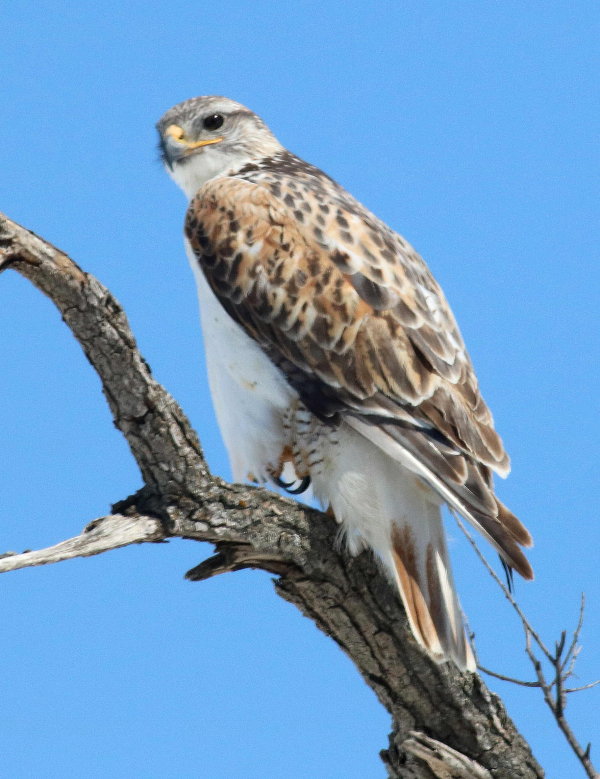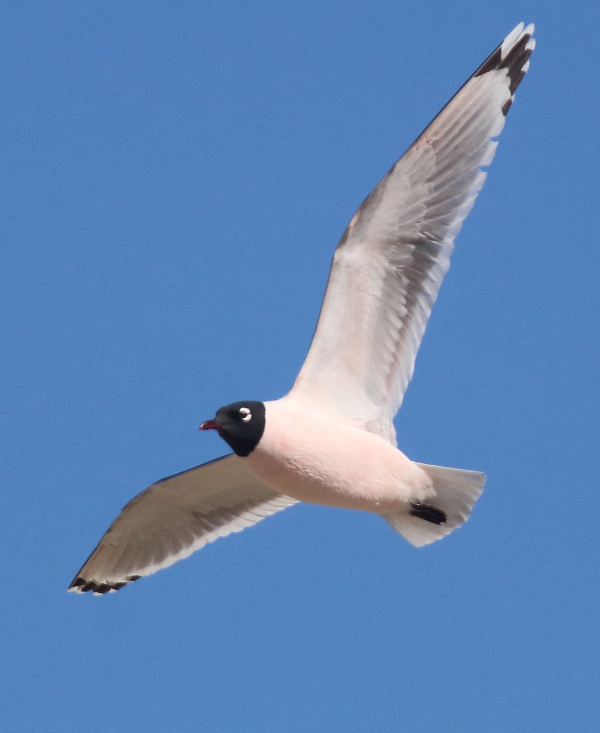
A passive period for the female Ferruginous Hawk on territory.

Friday there was a day-long migration of Franklin’s Gulls through the area. Notice the pink coloration on the underside of this Franklin’s Gull, which is most obvious during early spring.
|
After almost a week, last Monday provided an exciting second chapter for the Ferruginous Hawk update: The female appeared on site for the first time! After almost giving up hope that the Ferruginous Hawk pair might return and build a new nest, I was thrilled to see the big female Ferruginous Hawk standing on the hilltop 120 yards north of last year’s nest – where the Great Horned Owl was now incubating. Seeing the female return was very promising, and a moment later I spied the smaller male winging just two feet above the ground, headed straight for the female with an apparent ground squirrel in its talons.
It’s an important aspect of pre-nesting behavior for the male to bring food to the female, to recharge their pair bond, to symbolically show there is ample prey in the area, and to affirm the male’s hunting prowess and ability to provide food for the female, and eventually, for nestlings. The male dropped the prey in front of the female as he landed, then backed away a step with his tail spread and wings partly open as if in defense. I left with the hope of not interrupting their bonding on their former territory, even if they had no nest on site.
On my return trip, the female remained in position, so I drove around the area a bit, checking for the male and looking for potential new nesting sites they might use. A low willow tree, similar to the willow that held their last nest, looked promising on the west side of the hill; and it would keep a visual barrier between the hawks and owls. There is also a grove of 10-year-old cottonwoods to the north, and a mature tree belt to the northeast. Hmmm, will they nest nearby? Where?
During that short Monday drive, I also found the first incubating Red-tailed Hawks at two nests, and a highly territorial Red-tail at a third nest that had sticks added as new nesting material. And although not a raptor, a pair of Giant Canada Geese was on territory with the female incubating her completed clutch on a nest built in a shallow spot surrounded by water.
Tuesday, I couldn’t locate a Ferrug on territory during my first drive-by, but upon my return, the female was perched atop a tall cottonwood next to the road: Advertising the pair’s territorial stake perhaps? Or waiting for the male to bring food?
Wednesday, the female was standing on a hilltop north of the owl nest, while the male was perched in a cottonwood grove to the northwest of her. But Thursday, I couldn’t locate the Ferrugs. Friday morning, I became a bit worried when I couldn’t locate either Ferruginous Hawk; but during a late afternoon check I was elated to see the male standing on a hill north of the owl nest. I looked for signs of any nest building in the area, but nothing was obvious, so the spy game continues. Although I checked for the Ferruginous Hawks twice Saturday and twice Sunday, I was a bit disappointed not to see them in the area. Nonetheless, I’ll keep you posted next week. I’m still hoping the pair of prairie hawks will re-nest on their territory, or at least nearby.
Spring Sightings
There were, of course, plenty of other migratory birds in the area, dominated by ducks, geese, and Red-tailed Hawks, but new species for this spring included an American Avocet, Blue-winged Teal, and American Coots last Tuesday; a Song Sparrow fed beneath my feeders Wednesday (it represented a new yard species); Tree Swallows and a Belted Kingfisher were new Thursday; and Sabine’s Gulls, Ruddy Ducks, and a Turkey Vulture were firsts Friday, with a notable migration of Franklin’s Gulls throughout the day, along with scattered flocks of migrating Double-crested Cormorants. By Friday, most of the ice had melted from shallow wetlands in the region, but a few large lakes still had a deep cover of ice.
Saturday yielded several new species: A pair of Willets, a Great Egret, a pair of American Wigeons, a Pied-billed Grebe, a Common Snipe and, right on schedule for April 20, direct from the grasslands of southern South America to the northern grasslands of central North America – a Swainson’s Hawk, soaring low, but rising higher on a warm thermal with each circle it plied; then gliding off to the north, resuming its migration. More will follow; some will nest here. Speaking of which, I found two more incubating Red-tailed Hawks and a third standing on a nest. Plus I spied another incubating or brooding Great Horned Owl (number 8).
Sunday, more did follow; I sighted three more Swainson’s Hawks south of my home, along with a flock of about 30 Greater Sandhill Cranes flying into a strong north wind. It seemed like an unlikely day for migrating northward, but in addition to the Sandhills there was a pretty steady midday migration of raptors – mostly Red-tails and American Kestrels, along with one Sharp-shinned Hawk. The urge to migrate must have been strong to battle such a wind.
As I returned home, I was especially happy to verify a new Red-tailed Hawk nest just 240 yards southeast of my house. I’ve been watching the site inquisitively through the week. Having seen a hawk in the tree grove twice, I checked what seemed to be a potential addition to some barren cottonwood branches and dismissed the early development of the nest as another of the many squirrel nests in the tree grove. But Sunday, the hawks must have been nest building in earnest considering how built up the nest had become by afternoon. When I checked the nest with binoculars, I saw the head of a prone Red-tail on the new nest. It stood up to re-arrange a couple small branches, so I continued on my way – but how fun it will be to have an active hawk nest so close.
Article and photos by Paul Konrad
Share your bird sightings and photos at editorstbw2@gmail.com